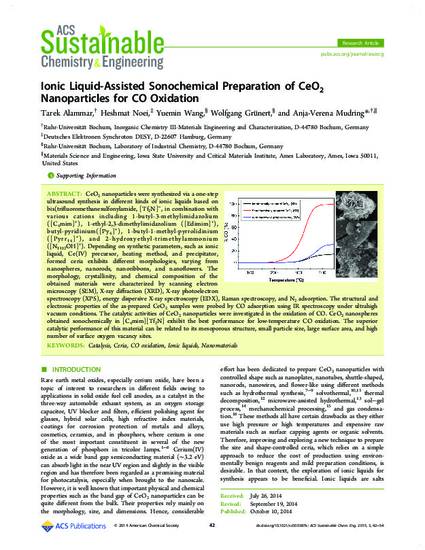
CeO2 nanoparticles were synthesized via a one-step ultrasound synthesis in different kinds of ionic liquids based on bis(trifluoromethanesulfonylamide, [Tf2N]−, in combination with various cations including 1-butyl-3-methylimidazolium ([C4mim]+), 1-ethyl-2,3-dimethylimidazolium ([Edimim]+), butyl-pyridinium([Py4]+), 1-butyl-1-methyl-pyrrolidinium ([Pyrr14]+), and 2-hydroxyethyl-trimethylammonium ([N1112OH]+). Depending on synthetic parameters, such as ionic liquid, Ce(IV) precursor, heating method, and precipitator, formed ceria exhibits different morphologies, varying from nanospheres, nanorods, nanoribbons, and nanoflowers. The morphology, crystallinity, and chemical composition of the obtained materials were characterized by scanning electron microscopy (SEM), X-ray diffraction (XRD), X-ray photoelectron spectroscopy (XPS), energy dispersive X-ray spectroscopy (EDX), Raman spectroscopy, and N2 adsorption. The structural and electronic properties of the as-prepared CeO2 samples were probed by CO adsorption using IR spectroscopy under ultrahigh vacuum conditions. The catalytic activities of CeO2 nanoparticles were investigated in the oxidation of CO. CeO2 nanospheres obtained sonochemically in [C4mim][Tf2N] exhibit the best performance for low-temperature CO oxidation. The superior catalytic performance of this material can be related to its mesoporous structure, small particle size, large surface area, and high number of surface oxygen vacancy sites.
Available at: http://works.bepress.com/anja_mudring/4/

Reprinted with permission from ACS Sustainable Chem. Eng., 2015, 3 (1), pp 42–54. Copyright 2015 American Chemical Society.